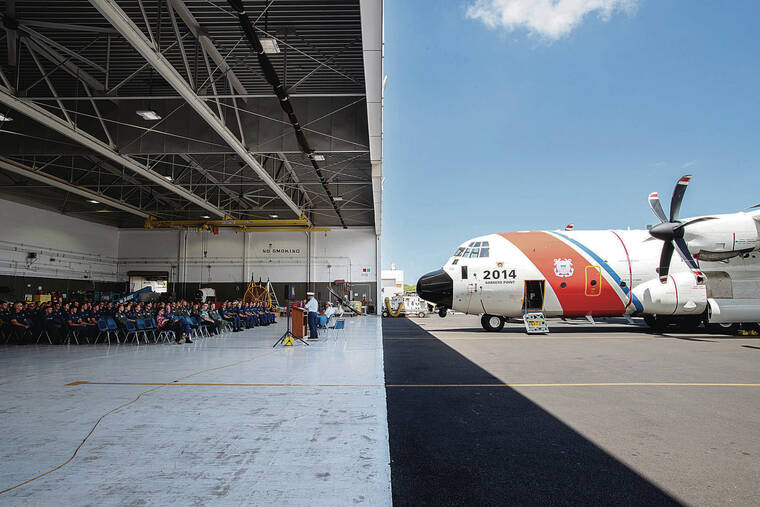The U.S. Coast Guard held a ceremony Friday at Air Station Barbers Point to mark its official transition from the C-130H airplane, which has flown out of the base since 1984, to the newer C-130J.
“While today we close the chapter on the C-130H in the story of Coast Guard aviation here at Barbers Point, we open a new chapter with the arrival of the C-130J, an aircraft that is more capable in every respect,” said air station commander Capt. John Rivers during remarks. “It is faster, stronger, more fuel- efficient, able to carry more weight, get into and out of austere locations and stay at the scene longer.”
After nearly five decades the H model was beginning to show its age, according to Coast Guard members. Operating in the Pacific is demanding, and Coast Guard District 14, headquartered in Honolulu, stretches across 14.4 million square miles of vast, blue ocean.
In addition to providing search-and-rescue and law enforcement support to the Hawaiian Islands and U.S. Pacific island territories, the Coast Guard is often called on by authorities and mariners from other Pacific island nations, many of which don’t have coast guards of their own.
“There’s many (search-and-rescue) cases that we respond to in Micronesia and Guam, and the H model didn’t quite have the range to be able to routinely get to Guam,” said pilot Lt. Cmdr. Scott Handlin. “This plane can make it to Guam in one leg, so our response time is shortened, particularly for search-and-rescue missions in the Western Pacific.”
The Coast Guard has historically struggled to get funding and new equipment, making due with what it has, as Congress has lavished funds on other military branches. But in recent years concerns about rampant illegal fishing and China’s growing influence in the Pacific has prompted efforts to boost the small service’s footprint in the region.
The first of the new J model aircraft arrived at Barbers Point in June 2021. Congress also approved funding for a new $45 million maintenance hangar at the base for the new planes. In total, Barbers Point received three of the planes.
“It’s like a completely different plane,” Handlin said. “Honestly, this thing is like a computer shaped like a C-130.”
Though the new plane greatly improves the Coast Guard’s reach, those who work with it admit the transition isn’t without challenges.
“You would think it’s just as simple as buying a brand-new car and everything’s peachy, but you have to have maintainers and aircrew that now have to get trained on the airplane,” Handlin said. “So there’s a period where we kind of have a lapse in qualified people to fly it.”
Among the aircraft’s new key features are upgraded cameras and sensors and the ability to transmit what they’re seeing in real time, which pilots said was a major game-changer.
“(Before), we’d have to come back, land, burn everything onto a DVD and print it out,” said pilot Lt. Kevin Carmichael. “Now we can actually push the imagery straight from the airplane through data link stuff, which is getting us into the modern century and also helps planners back at home.”
Among the Coast Guard’s priorities in the Pacific is tracking illegal and unreported fishing. In 2020 the Coast Guard’s then- commandant, Adm. Karl Schultz, who was succeeded Wednesday by Adm. Linda Fagan, said overfishing had surpassed piracy as the No. 1 ocean security threat, owing to the damage it was doing to coastal economies and food security.
But crimes at sea are often difficult to document and even harder to enforce. It can be unclear who a ship belongs to, where it’s ported and who has authority to act. The Coast Guard pilots said that being able to broadcast information in real time increases decision- makers’ ability to navigate those complexities.
“We’re more able to effectively prosecute illegal activities, whether it’s illegal drug or human trafficking or as well as illegal fishing activities,” Handlin said.
In early December, Palauan officials asked the U.S. Coast Guard for help tracking the Da Yang Hao, a Chinese survey vessel the Palauan government said illegally entered its waters in late November. A HC-130J based out of Barbers Point flew out to Palau and made radio contact with the vessel’s crew, which told the Americans they were waiting out a storm.
Before loitering in Palau’s waters, the ship had been spotted moving through the maritime territories of India, the Philippines and Malaysia. The Chinese government has been known to use a variety of ostensibly civilian vessels for military and intelligence-gathering missions, though the scope of these efforts is a subject of intense debate among analysts.
“We were able to get out there and get imagery, and that imagery was on the commandant’s desk the same day, and he was actually able to share it with regional partners … and keep them informed of what’s going on in their region,” Carmichael said. “The old plane would have taken multiple days to get out there. And then he would have had that delay of getting the imagery off.”










